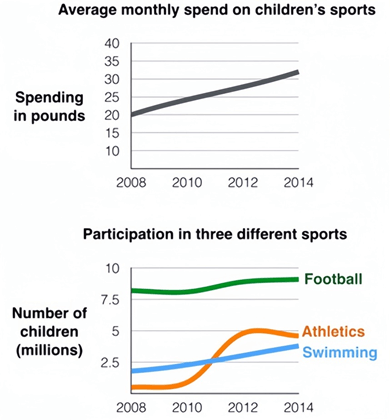5+ The first chart below gives information about the money spent by British parents on their
The first chart below gives information about the money spent by British parents on their children’s sports between 2008 and 2014. The second chart shows the number of children who participated in three sports in Britain over the same time period. Summarise the information by selecting and reporting the main features, and make comparisons where relevant. Write at least 150 words hay nhất giúp bạn có thêm tài liệu tham khảo để viết bài luận bằng Tiếng Anh hay hơn.
- The first chart below gives information about the money spent by British parents on their (mẫu 1)
- The first chart below gives information about the money spent by British parents on their (mẫu 2)
- The first chart below gives information about the money spent by British parents on their (mẫu 3)
- The first chart below gives information about the money spent by British parents on their (mẫu 4)
- The first chart below gives information about the money spent by British parents on their (mẫu 5)
5+ The first chart below gives information about the money spent by British parents on their
Đề bài: The first chart below gives information about the money spent by British parents on their children’s sports between 2008 and 2014. The second chart shows the number of children who participated in three sports in Britain over the same time period. Summarise the information by selecting and reporting the main features, and make comparisons where relevant. Write at least 150 words
The first chart below gives information about the money spent by British parents on their - mẫu 1
The line graphs provide insights into the average monthly expenditure by British parents on their children’s sports activities and the corresponding participation figures in football, swimming, and athletics from 2008 to 2014.
It is evident that parental spending on children’s sports witnessed a steady annual rise over the six-year period. In terms of participation, football emerged as the most favored sport, with significantly higher engagement compared to swimming and athletics.
In 2008, British parents allocated approximately £20 per month to their children’s sporting pursuits. This figure experienced a gradual upward trajectory, reaching slightly over £30 by the end of 2014.
Regarding the number of participants in various sports, football dominated the scene in 2008, attracting around 8 million British children. In contrast, swimming and athletics lagged behind, with approximately 2 million and less than 1 million participants, respectively. While football participation remained relatively stable over the subsequent six years, swimming witnessed an almost doubling of participants to nearly 4 million, and athletics experienced a nearly fivefold increase, reaching a substantial level.
The first chart below gives information about the money spent by British parents on their - mẫu 2
A rendered line chart shows how much money parents in Britain spent on their children’s sporting activities over a period of 7 years from 2008 to 2014 as well as the percentage of young people who participated in those three activities.
Overall, it is clear that only a tiny percentage of youths participated in the initiative’s athletics during the whole time period, while the final year had the highest percentage of expenditures.
From the first chart, it is evident that the average monthly spending on juvenile sports activities was around 20 pounds in the first year and 25 pounds in the second year, but it peaked at almost 32 million pounds in the previous year.
As observed from the second chart, when it comes to the number of sports participants in 2008, there were almost 1 million children taking part in athletics which gradually rose to a figure of nearly 5 million by 2014. Swimming, on the other hand, showed a steady rising pattern almost doubling in 2014 from nearly 2 million participants to close to 4 million. Conversely, football remained the most popular sport with its numbers exceeding the other two sports. The numbers, however, displayed a meagre rise. With the highest numbers recorded overall in 2008 (nearly 8 million), it stayed the highest in 2014 with participants reaching approximately 8.5 million.
The first chart below gives information about the money spent by British parents on their - mẫu 3
The line graphs show the average monthly amount that parents in Britain spent on their children’s sporting activities and the number of British children who took part in three different sports from 2008 to 2014.
It is clear that parents spent more money each year on their children’s participation in sports over the six-year period. In terms of the number of children taking part, football was significantly more popular than athletics and swimming.
In 2008, British parents spent an average of around £20 per month on their children’s sporting activities. Parents’ spending on children’s sports increased gradually over the following six years, and by 2014 the average monthly amount had risen to just over £30.
Looking at participation numbers, in 2008 approximately 8 million British children played football, while only 2 million children were enrolled in swimming clubs and less than 1 million practised athletics. The figures for football participation remained relatively stable over the following 6 years. By contrast, participation in swimming almost doubled, to nearly 4 million children, and there was a nearly fivefold increase in the number of children doing athletics.
The first chart below gives information about the money spent by British parents on their - mẫu 4
The graphs provide data about the amount of money British parents spent on their children’s sports over the period from 2008 to 2014 as well as the quantity of children who took part in three particular sports over the equivalent time span.
A brief analysis of the graphs indicates that the level on spending on children’s sports increased significantly, while participation in the three sports highlighted also grew overall.
In 2008, parents in Britain spent pounds per month on their offspring’s sports. However, this figure climbed steadily over the following six years, and by 2014 it stood at approximately 32 pounds.
Football had by far the highest level of participation throughout the period, with roughly 9 million participants in 2014, up from just over 8 million in 2008. In addition, athletics saw the largest overall increase, climbing substantially from under half a million children in 2008 to almost 5 million only 6 years later. Finally, the number of children taking part in swimming underwent strong growth, doubling from under 2 million to around 4.
The first chart below gives information about the money spent by British parents on their - mẫu 5
The capital expenditure of British parents on their child sports activities from 2008 to 2014 and the proportion of youth indulging in three activities in Britain is depicted by rendered line chart.
Overall, it can be vividly manifested that the maximum per cent of expenditure was in the final year whilst the minuscule percentile of teenagers involved in Athletics in the initiative throughout the period.
After analysing it, it can be clearly seen that with regard to the average monthly expenditure on youth sports activities in the initial year, it was about 20 pounds against 25 pounds in the following year; however, it reached a peak value of nearly 32 million in the last year.
Probing ahead, in connection with the participation in distinct sports in 2008, tops the list while it escalated by nearly 1 million in the final year. Nonetheless, nearly 1 million and 5 million juveniles participated in athletics correspondingly. Nevertheless, more than 2 million children indulged in Swimming activity in 2008, which remained steady until 2010 and witnessed an incline of about 1.5 million in 2014.
Xem thêm các bài luận Tiếng Anh hay khác:
Đã có app VietJack trên điện thoại, giải bài tập SGK, SBT Soạn văn, Văn mẫu, Thi online, Bài giảng....miễn phí. Tải ngay ứng dụng trên Android và iOS.
Theo dõi chúng tôi miễn phí trên mạng xã hội facebook và youtube:Nếu thấy hay, hãy động viên và chia sẻ nhé! Các bình luận không phù hợp với nội quy bình luận trang web sẽ bị cấm bình luận vĩnh viễn.
- Đề thi lớp 1 (các môn học)
- Đề thi lớp 2 (các môn học)
- Đề thi lớp 3 (các môn học)
- Đề thi lớp 4 (các môn học)
- Đề thi lớp 5 (các môn học)
- Đề thi lớp 6 (các môn học)
- Đề thi lớp 7 (các môn học)
- Đề thi lớp 8 (các môn học)
- Đề thi lớp 9 (các môn học)
- Đề thi lớp 10 (các môn học)
- Đề thi lớp 11 (các môn học)
- Đề thi lớp 12 (các môn học)
- Giáo án lớp 1 (các môn học)
- Giáo án lớp 2 (các môn học)
- Giáo án lớp 3 (các môn học)
- Giáo án lớp 4 (các môn học)
- Giáo án lớp 5 (các môn học)
- Giáo án lớp 6 (các môn học)
- Giáo án lớp 7 (các môn học)
- Giáo án lớp 8 (các môn học)
- Giáo án lớp 9 (các môn học)
- Giáo án lớp 10 (các môn học)
- Giáo án lớp 11 (các môn học)
- Giáo án lớp 12 (các môn học)






 Giải bài tập SGK & SBT
Giải bài tập SGK & SBT
 Tài liệu giáo viên
Tài liệu giáo viên
 Sách
Sách
 Khóa học
Khóa học
 Thi online
Thi online
 Hỏi đáp
Hỏi đáp

